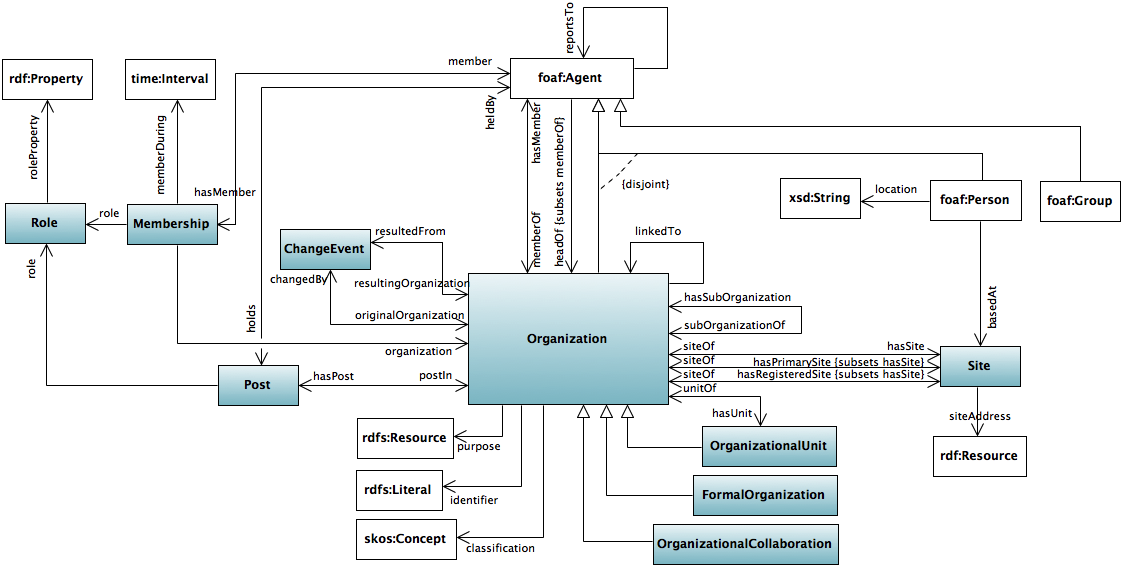- From: Joćo Paulo Almeida <jpalmeida@ieee.org>
- Date: Thu, 02 May 2013 12:19:43 -0300
- To: Richard Cyganiak <richard@cyganiak.de>, "GLD Working Group, (Government Linked Data)" <public-gld-wg@w3.org>
- Message-ID: <CDA8076A.6B76D%jpalmeida@ieee.org>
Dear All, Thanks for you comments. I attach a new version of the diagram. I've addressed most of the comments: - Single colon is used instead of '::' to represent namespace scoping - vcard is no longer the range of siteAddress (in the absence of a range, I've used rdf:Resource, is this OK?) - navigability is always shown - foaf:Group is aligned vertically with foaf:Agent With respect to the aesthetics, I am not in favour of using rounded corners, as this would no longer be a UML diagram. I am in favour of standards :-) Drop shadows are not possible in the tool. About clickable parts, this is just a matter of making an area map in html. I can do that once we agree on the diagram. Regards, Joćo Paulo On 1/5/13 10:00 AM, "Richard Cyganiak" <richard@cyganiak.de> wrote: >Dave, Joćo, > >Comments on the proposed diagram, in addition to what Dave said: > >1. I understand the semantics of the distinction between gray and white >boxes. But why is the Organization class colored differently? Just >because it's the most important one? If that's the case, its size and >central position are sufficient to communicate that, and it doesn't need >to have a different color. > >2. I agree with Dave that the diagram looks a bit bland. Can it be made a >bit more visually interesting? Rounded corners, drop shadows, anything? > >3. Personally I would prefer if the connections that have inverses would >have arrows on both ends, rather than on no end. > >4. I think the member connection and the hasMember connection both lack >an arrow. > >5. Minor point regarding the layout: Organization, foaf:Group and >foaf:Person have something in common: They are all subclasses of >foaf:Person. But in the arrangement, they have nothing in common, and are >positioned quite differently. > >6. The colors besides black and white should be picked, if possible, from >the color palette already used in http://www.w3.org/TR/vocab-org/ , to >make it fit in nicely. > >Best, >Richard > > >On 1 May 2013, at 12:35, Dave Reynolds <dave.e.reynolds@gmail.com> wrote: > >> Hi Joćo Paulo, >> >> [Sorry to be slow to respond, just too busy :(] >> >> Many thanks for this. It is definitely an improvement over the earlier >>version. Does this technology offer clickable images as as well? >> >> The diagram shows the range of org:siteAddress as being vcard:Vcard yet >>this is no longer the case, vcard is now simply a recommended option. >>With your tooling is it possible to grey out boxes? >> >> The use of double '::' is incorrect from an RDF point of view. With >>your tooling is it possible to use single ':' instead? >> >> Aesthetically it's a little uninspiring but acceptable. >> >> Do other working members having opinions on whether to adopt this (with >>above tweaks) in preference the current diagram? >> >> Dave >> >> On 18/04/13 15:15, Joćo Paulo Almeida wrote: >>> Dear All, >>> >>> Please find attached our proposal of diagram for ORG. It is a complete >>> diagram (only a transitive derived property is ommitted, the rest is >>>all >>> in). >>> >>> I've tried to address the issue that Dave raised with respect to the >>> representation of attributes. >>> >>> Of course, we could produce a simplified version (leaving some elements >>> out). >>> >>> We have followed a number of conventions to represent the ontology in >>>UML: >>> - Classes in white are imported from other vocabularies >>> - Navigability is only shown (arrows) in case the property does not >>>have >>> an inverse >>> - Non-disjoint subclass specialisation is shown with different arrows >>>to >>> favour correct interpretation >>> >>> >>> Best regards, >>> Joćo Paulo >>> >>> >>> On 12/4/13 9:02 AM, "Joćo Paulo Almeida" <jpalmeida@ieee.org> wrote: >>> >>>> Dear Phil, >>>> >>>> We can do that. That is, we'll make a proposal and bring it to the >>>>group. >>>> I hope we'll be able to address the concern Dave raised with respect >>>>to >>>> the diagram we produced earlier for ORG, and I believe we can build >>>> consensus on some form of graphical representation. >>>> >>>> I am sorry I was not able to join in the discussion today on >>>>ORG/RegOrg. >>>> This is because Brazil is -5 hours with respect to Dublin time. >>>> >>>> Regards, >>>> Joćo Paulo >>>> >>>> >>>> On 12/4/13 7:06 AM, "Phil Archer" <phila@w3.org> wrote: >>>> >>>>> During the face to face meeting (still ongoing), we've been >>>>>discussing a >>>>> comment concerning the diagram for the ORG ontology. This highlights >>>>>the >>>>> fact that all those of us who have created diagrams for our vocabs >>>>>use >>>>> different tools and create different-looking diagrams. >>>>> >>>>> Ideally, we'd like them all to have the same look and feel. And even >>>>> more ideally we'd like the diagrams to be clickable so you can jump >>>>>to >>>>> the relevant definitions etc. That's a nice to have, not a >>>>>requirement. >>>>> >>>>> Do you have the tooling and/or the time to help create these please? >>>>> >>>>> Phil. >>>>> >>>>> >>>>> -- >>>>> >>>>> >>>>> Phil Archer >>>>> W3C eGovernment >>>>> http://www.w3.org/egov/ >>>>> >>>>> http://philarcher.org >>>>> +44 (0)7887 767755 >>>>> @philarcher1 >>> >> >> > >
Attachments
- image/png attachment: OrgOntology20130502.png

Received on Thursday, 2 May 2013 15:20:22 UTC